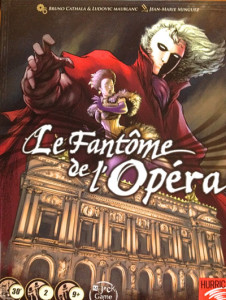
This past Christmas, I participated in BoardGameGeek’s Secret Santa. It’s a pretty huge event, with over a thousand people signing up to send complete strangers brand-new board games. This was my first year giving it a go, and I could not have been happier with my experience. Not only did my Santa send me Forbidden Desert and Ghost Stories, two games that have been on my radar for a while, but they also sent the hard-to-find (at the time) Le Fantôme de l’Opéra. I’d heard about Fantôme when I read a preview of the new games premiering at Essen, and the theme alone sold me. Phantom of the Opera is kind of my guilty pleasure – I adore the musical, and even liked the Gerard Butler movie. My mom is a bigger fan than me, so I knew I had to get this game as soon as it came out. Thanks to my Secret Santa, though, I didn’t have to! If you’re reading this, Santa, you’re awesome. So what is this game all about? Did it live up to my expectations? Let’s find out.
Overview:
Le Fantôme de l’Opéra
Publisher and Date: Hurrican, 2013
Designers: Bruno Cathala and Ludovic Maublanc
Players: 2
Ages: 9 and up
Length: 30 minutes
BoardGameGeek Link: Le Fantôme de l’Opéra
You’ll like this if you like: Mr. Jack, Clue, or any strategic bluffing game
Gameplay/Rules:
Le Fantôme de l’Opéra is strictly a two-player game. One person plays as the phantom, while the other plays as the investigator. For the phantom to win, you must elude the investigator until La Carlotta becomes so frightened that she flees the theater. As the investigator, you want to catch the phantom by ruling out suspects until only one is left; you must do this before La Carlotta leaves. All your favorite Phantom of the Opera characters are here as suspects – there are eight in total: Christine Daaé, Meg Giry, Madame Giry, Raoul de Chagny, Joseph Buquet, M. Moncharmin, M. Richard, and Le Persan. Each suspect has different abilities that allow them to elude the investigator. Gameplay is easy to learn, but it takes a few rounds until you remember the abilities. Thankfully, each character card has instructional iconography that helps you along.
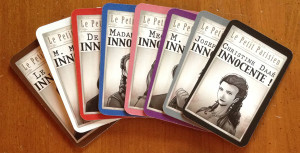
At the start of each game, eight character tokens are placed on the board, each one in the various rooms of the Paris opera house. Two of the tokens, Madame Giry and Joseph Buquet, have tokens that are placed with them and add to their special ability. The person playing the phantom picks a card from the alibi pile, which is comprised of the eight characters plus a phantom card. The card you choose is the phantom for the game; you keep this identity hidden from the investigator. The remaining cards in the pile are shuffled and kept to the side of the board. There is another set of eight cards (named character cards) which picture the suspects and the iconography for their special ability. Shuffle these, and put four of them face-up in a row. Place the other four nearby, as you will be using them in the next turn. You’re now ready to start playing – setup is simple and quick.
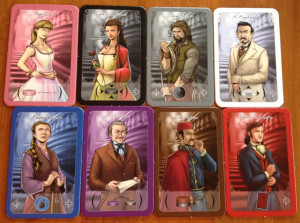
The investigator goes first. They choose one of the four face-up character cards, and move that character’s token on the game board, using their special ability. The phantom then chooses two of the cards and performs their movements. The investigator must now move the remaining card’s character token. After all four cards have been used up, the investigator asks if the phantom can appear and cause a frightening event. Looking at the board and the new placement of the tokens, the phantom must answer honestly. The phantom can appear if his character (the one he pulled from the alibi deck) is with other tokens in a lighted room. He cannot appear if he is alone in a room, or in an unlit room. Based on the phantom’s answer, suspects will be found innocent, and you can turn their token over to show this. The innocent side of the token is in black and white, while the suspect side is in color. Count the number of suspects remaining on the board, and move the La Carlotta tracker forward an equal number of spaces. She is now that much closer to fleeing the opera house. The next four action cards are then turned face-up, and play continues; this time, the phantom goes first and picks one card. Then the investigator picks two, and finally, the phantom plays the last card. After that, the question is again asked if the phantom can appear. Hopefully, as the investigator, you were able to eliminate more suspects. Otherwise, you have to move La Carlotta again. After all eight cards are played, reshuffle them, and turn four face-up. Continue playing until La Carlotta flees the opera house (phantom wins), or there is one remaining suspect (investigator wins).

The character cards that I mentioned are the crux of the game. Each card has a picture of the character, along with iconography that helps you remember how their tokens can move on the board. The characters all have unique movement abilities, which I’ll explain below. These abilities could be activated before or after movement, and some are optional. One just needs to look at the iconography to decipher this.
Christine Daae can pull other characters into her room from adjacent rooms. Remember, the phantom can’t appear if they are with other characters, unless the room is unlit.
Meg Giry can move using the secret pink passageways.
Madame Giry can use her padlock token to block passageways.
M. Richard has the option to switch places with another character token.
Joseph Buquet has the ability to turn the lights off in a room with his special chandelier token – the phantom cannot appear if he is in an unlit room, so this comes in handy.
M. Moncharmin does the opposite of Christine, and pushes characters away from him to adjacent rooms.
Le Persan can pick up a token in the same room as him and move them along with him. He can carry the other character with him until the end of his movement, or he can drop them off on his way to another room.
Raul de Chagny moves normally, but he allows you to pick a card from the suspect deck and mark that suspect as innocent. If he draws the phantom card, he moves La Carlotta forward one space. If he draws a suspect that is already marked as innocent, nothing happens.
All characters must move if you pick them. You can move at least one space, unless there are other characters in the room with you – then you move spaces equal to the number of tokens in that room. For example, if you pick Le Persan, and he is in a room with three other tokens, you can move him (along with another token because of his special ability) four spaces. If you were to pick Madame Giry, and she is in a room with two other tokens, you could move her three spaces – you would also place her padlock token on any passageway in order to block it.
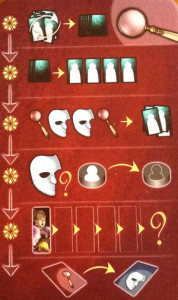
Gameplay is fairly quick once you get the hang of it. It’s possible to play this two or three times in an hour, unless you’re playing with someone prone to analysis paralysis. Trying to figure out where to move the tokens in order to maximize your chances of escaping the investigator or catching the phantom is tricky – but that’s what makes this so fun. Teaching Le Fantôme to non-gamers should be easy, since the mechanics are simple enough to grasp, but keep the instruction booklet handy as you will continuously reference it while learning the special character abilities. Also, you can start La Carlotta closer to the end space or farther away to adjust the difficulty level. I like that the designers included a handy card that reminds you of the turn order and game actions; this will help newcomers follow the sequence of events in Le Fantôme.
Design:
The artwork is gorgeous. Cathala and Maublanc, who also designed the Mr. Jack game series and SOS Titanic, did a fantastic job. I love the detail on the character cards, and the thickness of the cards in general. They are all heavy cardboard, which will make the game hold up for a long time. The two decks have different-colored backs on them to tell them apart. The tokens are made of wood, in various colors, and you put the character stickers on them yourself when setting up the game for the first time. The game board is dripping with theme; it looks so mysterious, and you really feel like you’re sneaking around the dark, old opera house. It is easily one of the most beautiful games I own. The few complaints I have about the design are access issues, which I will discuss in the “gimp glimpse” section below.
Replay Value:
I’ve played this over ten times since I got it (that’s a lot for me), so that should tell you something right there. My nurse usually requests this when we pick a game to play. Since the phantom is a different character every time, and you can choose from two roles, the replay value is extremely high. I’ll probably keep this game in my collection for a while, because I can’t see myself getting bored with it any time soon.
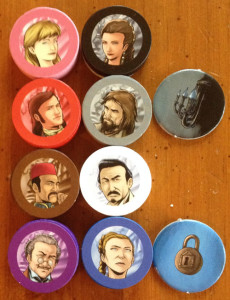
The Gimp Glimpse:
Color blind and visually impaired individuals will have a lot of trouble with this game. I am neither, and I sometimes have trouble differentiating between the colors on the tokens. The suspect side of the token is in color, and the innocent side is black and white – but it is often difficult to see which is which. This may have a lot to do with the crappy lighting in my kitchen, but I imagine others will have the same problem. Also, the character names are written in a handwriting font, which may be hard for some to decipher. If you need the rules in PDF format, you’re out of luck; BoardGameGeek and the publisher’s site do not provide files. I’m hoping to e-mail the designer soon to see if we can put something up on either site. As far as other physical disabilities, placing the stickers on the tokens may prove troublesome, but that is only a one-time deal.
Score:
Four-and-a-half stars out of five. I love this game, plain and simple. The color issues are sometimes annoying (and I’m sure even more annoying for color blind gamers), which is why I knocked off half a star. But definitely pick this up if you like the theme, and enjoy deduction games!

Just wanted to ask: does the secret santa still happen on Boardgamegeek?
Yep, it does! They usually announce sign ups in October, I think. It’s one of my favorite things to do for the holidays!
Nice review!
Just a proof-reading note: I believe you used “can appear” when you meant “can’t appear” and visa versa a couple of times in this review. You might want to double check to make sure they are all in order.
Thanks! You’re probably right, but I haven’t played this game since I reviewed it (and no longer have a copy), so I’m not entirely sure what is correct. But hopefully gamers can figure it all out 🙂